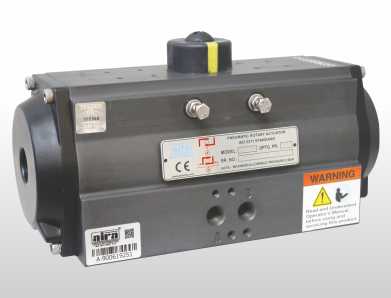What is a Pneumatic Actuator?
Pneumatic actuators convert compressed air energy into mechanical motion. It is commonly used in industrial applications to automate valves, gates, and other mechanical components. Pneumatic actuators come in various types and sizes, ranging from small handheld devices to large-scale industrial systems.
The basic operation of a pneumatic actuator involves the use of compressed air to move a piston or a diaphragm. As the air is introduced into the actuator, it creates pressure that drives the piston or diaphragm in one direction. The direction of motion is controlled by a set of valves that regulate the flow of compressed air.
Pneumatic actuators are widely used in various industries, including manufacturing, chemical processing, oil and gas, and automotive. They are preferred over other types of actuators because they are reliable, easy to maintain, and cost-effective.
Types of Pneumatic Actuators and Their Applications
There are several types of pneumatic actuators, each with its own set of advantages and disadvantages. Among the most common pneumatic actuator types are:
- Linear actuators: Linear actuators convert compressed air into linear motion. They are commonly used in applications where a linear force is required, such as in conveyor systems and hydraulic presses.
- Rotary actuators: Rotary actuators convert compressed air into rotary motion. They are commonly used in applications where a rotary force is required, such as in robotics and automation.
- Gripper actuators: Gripper actuators are used to grip and release objects. They are commonly used in assembly lines and packaging systems.
- Diaphragm actuators: Diaphragm actuators use a flexible diaphragm to convert compressed air into mechanical motion. They are commonly used in applications where a high level of precision is required, such as in control valves.
- Scotch yoke actuators: Scotch yoke actuators use a yoke-shaped mechanism to convert compressed air into mechanical motion. They are commonly used in applications where a high level of torque is required, such as in pipeline valves.
Each type of pneumatic actuator has its own set of advantages and disadvantages. For example, linear actuators are simple and reliable, but they are limited in terms of stroke length. Rotary actuators are versatile and efficient, but they can be expensive and complex to install. Gripper actuators are useful for picking and placing objects, but they require a high level of maintenance. Diaphragm actuators offer high precision and accuracy, but they can be sensitive to temperature and pressure fluctuations. Scotch yoke actuators are powerful and durable, but they can be heavy and bulky.
Advantages and Disadvantages of Pneumatic Actuators
Pneumatic actuators offer several advantages over other types of actuators, such as hydraulic and electric actuators. Some of the advantages of pneumatic actuators include:
- Cost-effective: Pneumatic actuators are generally less expensive than hydraulic or electric actuators, making them a cost-effective solution for many industrial applications.
- Simple and reliable: Pneumatic actuators have a simple design and are easy to maintain, making them a reliable choice for industrial applications.
- High force and speed: Pnematic actuators can generate high forces and operate at high speeds, making them suitable for applications that require quick and precise movements.
- Explosion-proof: Pneumatic actuators are intrinsically safe and can operate in hazardous environments, making them suitable for applications in the oil and gas, mining, and chemical industries.
However, there are also some disadvantages to using pneumatic actuators. These include:
- Limited control: Pneumatic actuators can only operate in two positions – fully open or fully closed. They are not suitable for applications that require partial opening or precise control.
- Noisy operation: Pneumatic actuators can be noisy during operation, which can be a problem in some applications.
- Limited temperature range: Pneumatic actuators are limited in terms of temperature range, as the compressed air can freeze or condense in extreme temperatures.
- Limited energy efficiency: Pneumatic actuators are not as energy-efficient as electric actuators, as they rely on compressed air to generate mechanical motion.
Factors to Consider when Choosing a Pneumatic Actuator
When choosing a pneumatic actuator for a specific application, there are several factors to consider. These include:
- Operating environment: The operating environment will determine the type of pneumatic actuator that is suitable for the application. For example, if the application involves exposure to extreme temperatures or corrosive materials, a diaphragm or bellows actuator may be more suitable than a piston or rotary actuator.
- Required force and speed: The required force and speed will determine the size and type of pneumatic actuator that is suitable for the application. For example, if the application requires high force and speed, a rotary or Scotch yoke actuator may be more suitable than a linear or diaphragm actuator.
- Control requirements: The control requirements will determine the type of valve and positioner that is required to operate the pneumatic actuator. For example, if the application requires precise control, a positioner may be required to ensure accurate positioning of the actuator.
- Maintenance requirements: The maintenance requirements will determine the type of pneumatic actuator that is suitable for the application. For example, if the application requires minimal maintenance, a linear or rotary actuator may be more suitable than a diaphragm or bellows actuator.
Conclusion:
Pneumatic actuators are widely used in various industries for their reliability, cost-effectiveness, and versatility. There are several types of pneumatic actuators available, each with its own set of advantages and disadvantages. When choosing a pneumatic actuator for a specific application, it is important to consider factors such as the operating environment, required force and speed, control requirements, and maintenance requirements. With the right selection of pneumatic actuator, businesses can improve their operational efficiency, reduce maintenance costs, and increase their bottom line.


